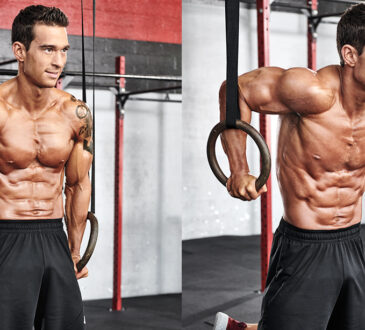
Setting weight loss goals can sometimes be a lost cause. Many of us have the right ideas; we know we should?eat right and exercise regularly, but in practice, it never quite works out.
The University of Scranton conducted a study that found that while losing weight was the number one goal of many individuals, only 8% of said individuals actually got to their goal.
But you¡¯re not a statistic. If you¡¯re on this site, you¡¯ve got the discipline to achieve your goal, but you may not have the know-how. Fortunately, it¡¯s not complicated. Here are 14 tried-and-true ways to get lean.
1 of 14

Set Up Circuits
Doing exercises back to back with little or no rest is one of the all-time most popular fat-loss training methods. It gets your heart rate up, burning lots of calories, and lets you work the whole body in a short period of time, which encourages the release of testosterone and growth hormone.
A circuit can be done with as few as three exercises. Pick a lower-body lift, a push, and a pull (the exact order doesn¡¯t matter). To build maximum muscle, you could do classic strength exercises like the squat, bench press, and chinup in circuit fashion, but adjusting weights and rack height can be cumbersome and time consuming in a crowded gym. Dumbbells are great tools for circuits, and if you choose the right exercises, you may be able to use the same pair for every lift. Try a circuit with a dumbbell front squat to press, dumbbell row, and dumbbell Romanian deadlift.
2 of 14

Make it Complex
Similar to circuits, barbell complexes combine lifts whose movements flow into each other, so you can keep a brisk pace while working the whole body. You can choose one weight and stand in one spot. You¡¯ll still be gasping for breath when it¡¯s over.
Each exercise in a complex should set you up for the next one so you can perform the reps immediately. For instance, the finish position of a hang clean puts you in the starting position for a front squat. After the squat, you can press the bar straight overhead (a military press), and from there, perform an overhead lunge. Try that combination for five reps each, resting only after you¡¯ve completed all four exercises. Start with just 25 pounds on each side of the bar. That¡¯s usually enough for most trainees who are new to complexes.
3 of 14

Go with the O
The aforementioned hang clean is a type of Olympic lift¡ªa variant on the clean and jerk, which is contested in weightlifting at the Olympic games. All the ¡°O¡± lifts can be used to increase fat loss, as they recruit enormous amounts of muscle mass. Try doing three to five sets of cleans or snatches first in your workout, or blend them into circuits or complexes. Done for higher reps, they increase the heart rate dramatically. Done for low reps, they build and maintain muscle mass, which is critical when dieting.
4 of 14

Jump Rope Between Sets
Did you know that you actually burn more calories from your body fat stores when you¡¯re resting between sets than you do lifting weights? That¡¯s because your body uses oxygen to refuel your muscle, and that process breaks down fat. You can encourage more fat burning at this time by performing light exercise, such as jumping at an easy pace, for a minute or so.
5 of 14

Limit Your Fruit
I¡¯m not in the camp that thinks fruit is equivalent to candy and should be banned from the diet like any other sugar, but I do believe it must be restricted to maximize fat loss. The liver converts extra fructose to fat, so it¡¯s best to save bananas, oranges, apples, and so on for when you really need them¡ªpost workout. Have one to two pieces to stop muscle breakdown after training and stick with vegetables and a limited amount of starches the rest of the day.
6 of 14

Cut Back on Fat
With the rise of low-carb diets, many people have increased their fat intake. It¡¯s true that eating low carb does allow you to eat more fat without fear of weight gain, but eating too much will prevent weight loss. Not only is fat calorically dense, but it can throw off your ratio of omega-6 to omega-3 fats, leading to inflammation. Interestingly, because low-carb diets cause your body to burn fat more efficiently, overeating bacon, beef, cheese and other sources supplies the body with so much dietary fat that it has no reason to break down the stuff hanging around your gut. In other words, you defeat the purpose! Only 20¨C30% of your calories should come from fat.
7 of 14

Set a Time Limit
You should encourage yourself to work harder and faster in the gym whenever possible, not just to raise your heart rate but to help you get your workouts done in a shorter period. One way to do this is to set a time limit. Give yourself, say, 20 minutes, and choose two exercises for opposing muscle groups. Say you want to work your legs and back. You could do leg presses and pullups, alternating sets of each for 10¨C12 reps per set (go short of failure each set). Continue back and forth, resting as needed, until 20 minutes is up. Make note of the rest you took and the total number of reps you performed. The next time you repeat the workout, try to do more reps or cut back on the rest.
8 of 14

Do Fast and Slow Cardio
Trainers today love to recommend intervals, but long, slow cardio works well too. Not only does it condition the heart, but it burns calories more directly from fat than higher-intensity exercise does. It can also be done anytime and often without posing a risk for muscle loss. Take walks first thing in the morning in a fasted state; ride a bike or swim laps. Aerobic sessions lasting 20¨C45 minutes can speed fat loss enormously.
9 of 14

Eat When You Can
When I started writing about and researching diets, most experts recommended eating frequently¡ªup to six meals a day. We know now that such a steady supply of food doesn¡¯t boost the metabolism like once thought, and in fact, there is no optimal number of meals. What counts is the number of calories you consume and where those calories come from. The new Food Pyramid I designed for my book along with Nate Miyaki, John Meadows, and other top nutritionists lays out easy modifications to one basic diet that optimizes it for fat loss or muscle gain. Basically, as long as you eat healthy food in certain proportions, it doesn¡¯t matter if you eat six times a day or once (as some intermittent fasters do). Make a plan that suits your schedule and preferences.
10 of 14

Eat LESS Variety
It¡¯s true that the more colors you can fit on the plate, the more complete the nutrition in your diet will be, but when you¡¯re dieting, you have to do what you can to make things easier on yourself. A strict diet doesn¡¯t leave much room for gourmet cooking, and most of us don¡¯t have the time anyway. Pick a few delicious meals that suit your diet and eat them regularly. You¡¯ll save yourself the grief of having to make long shopping lists and counting calories and macros all the time. When you know how many grams of carbs are in your staple meals, you can just eat them and let the diet worry about itself.
11 of 14

Stir Fry
One of the simplest and most well-rounded meals you can make is a stir fry. Heat a pan, throw in some meat and vegetables, and serve over rice (or not, if you¡¯re going very low carb). Stir frys save you cookware and time, allowing you to prepare an entire meal in one pan, and there are endless options. Stir frys don¡¯t always need to be Asian in flavor¡ªtry Mexican and Italian seasonings for more diverse cooking.
12 of 14

Climb Ladders
The rowing machine is a deadly fat-burning tool, but if you weren¡¯t on your college crew team, you may not know how to use it. Performing ladders makes for efficient training, building your intensity gradually and then keeping it high even as you fatigue.
Row for 100 meters and then rest 30 seconds. Row 200 meters and rest again. Continue climbing this ¡°ladder¡±, adding 100 meters at a time until you reach 500. At that point, work your way back down to 100 meters. Even though you¡¯ll be working for less and less time in the latter half of the workout, each round will feel harder and harder.
13 of 14

Train Strongman
I¡¯ve used strongman training methods in my workouts for the past year and even competed in a strongman show. Subsequently, my abs have never been stronger and my conditioning is much improved. If you can, get your hands on Atlas stones or a Husafell stone. Not only will they build overall brute strength, but they can serve as tremendous finishers for a workout, allowing you to burn more calories. Strongman also promotes testosterone and growth hormone release, which sets the stage for muscle growth and fat loss.
Loaded carries, as with the Husafell, can be a form of interval training. If you don¡¯t have access to this kind of equipment, carrying a keg, sandbag, or very heavy dumbbells for a farmer¡¯s walk is a good substitute.
14 of 14

Eat Some Carbs
Just as you don¡¯t want to overdo it on fat, you don¡¯t want to under-do your carbs. Strength training is an anaerobic activity and requires glycogen for fuel. Cutting your carbs to zero can work for a little while, but it isn¡¯t necessary and it will ultimately cost you muscle. As popular and effective as low-carb diets are, people who weight train hard rely on carbs and can eat many more of them than sedentary folk without consequences. I¡¯ve never heard of a Mr. Olympia winner who walked around with 0 grams of carbs in his system¡ªmy point being that you can get very lean while still eating your rice, potatoes, and fruit.
?




